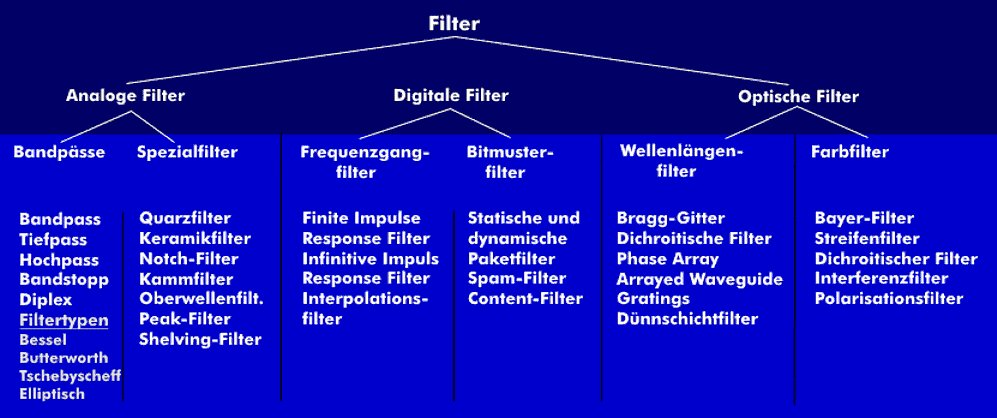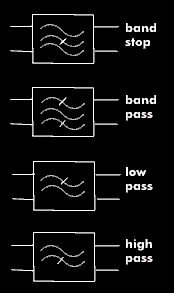filter
A filter is a frequency-selective circuit that blocks certain frequencies, wavelengths or bit patterns while allowing others to pass. In general, a classification can be made according to filter type and technology, namely passive and active analog filters, digital filters, optical filters and color filters.
Analog filters are those that select certain frequencies and let them pass, while blocking others. Therefore, a distinction is made in the frequency range between the passband( DB) and the blockband( SB). The same applies to optical filters, but with the difference that they pass certain wavelengths and block others.
The distinction between digital filters is more difficult. There are those that emulate the function of analog filters, i.e. perform a frequency-based selection, and others that analyze bit patterns.
To summarize, analog filters are used for frequency selection in communications technology, optical filters for wavelength selection in optical transmission technology, and digital filters for bit pattern selection in data communications.
- InLF technology, RF technology and communications technology, analog RF filters are used in passive or active technology. Corresponding filters operate on a frequency-selective basis and are used in all analog transmission technology equipment such as amplifiers, transmitters, receivers, antennas, transmission links. The filtering techniques used in them, such as high-pass, low-pass, band-pass, band-stop and diplex filters, allow certain frequency ranges to pass, while blocking others. Analog filters that operate on a frequency basis consist of active resistors, capacitors and inductors, i.e. LC or RC elements. In addition to the RC and LC filters, there are also the crystal filter and the ceramic filter, which operates on a dielectric basis. Important characteristic values of analog filters, which determine the transmission behavior, are the bandwidth and half-width, the attenuation behavior, which is also reflected in the slope, the phase behavior and the group delay.
- In addition to analog filters, digital filters are also used in communications engineering to simulate analog filter functions. These include the FIR filter or the IIR filter, which determine the frequency response curves by implementing mathematical models.
- In communications technology, digital filters are used to select bit patterns. These digital packet filters can filter out addresses for optimal routing or load separation, they are used in firewalls, for virus protection or against spam mails, as content filters, mail filters, spam filters, upload filters and Bozo filters. A variant of the digital filters are the character filters. They can be used to filter out format characters, control characters or other characters from a data stream.
- Optical filters can be wavelength filters or color filters. The optical wavelength filters are mainly used in optical transmission technology and in wavelength division multiplexing. This group includes the Bragg grating, dichroic filters, phase arrays, and thin film filters.
- Color filters are used in digital cameras and in video cameras, but also in scanners, displays and projectors. In the case of devices working with image sensors, it is the case that the image sensors are only sensitive to brightness and therefore the recorded brightness signals must be separated into their color components.
- In image processing, filter techniques are used for blurring, brightening or darkening sections of the image, increasing contrast, creating masks and inserting new image details.


